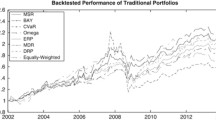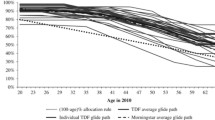Abstract
We study the problem of diversifying a given initial capital over a finite number of investment funds that follow different trading strategies. The investment funds operate in a market where a finite number of underlying assets may be traded over finite discrete time. We present a numerical procedure for finding a diversification that is optimal in the sense of a given convex risk measure. The procedure is illustrated on an asset-liability management problem where the liabilities correspond to a pension insurance portfolio.






Similar content being viewed by others
References
Aro H, Pennanen T (2011) A user-friendly approach to stochastic mortality modelling. Eur Actuar J. doi:10.1007/s13385-011-0030-4
Ben-Tal A, Nemirovski A (2001) Lectures on modern convex optimization. MPS/SIAM series on optimization. Society for Industrial and Applied Mathematics (SIAM), Philadelphia
Berkelaar AB, Coche J, Nyholm K (eds) (2010) Interest rate models, asset allocation and quantitative techniques for Central Banks and Sovereign Wealth Funds. Palgrave Macmillan, Hampshire
Black F, Jones R (1987) Simplifying portfolio insurance. J Portfolio Manag 14(1):48–51
Black F, Perold AF (1992) Theory of constant proportion portfolio insurance. J Econ Dyn Control 16:403–426
Bodie Z, Treussard J (2007) Making investment choices as simple as possible, but not simpler. Financial Anal J 63(3):42–47
Engle RF, Granger CWJ (1987) Co-integration and error correction: representation, estimation, and testing. Econometrica 55(2):251–276
Föllmer H, Schied A (2004) Stochastic finance. de Gruyter Studies in Mathematics, extended edition, vol 27. Walter de Gruyter & Co., Berlin
Hilli P, Koivu M, Pennanen T (2011) Cash-flow based valuation of pension liabilities. Eur Actuar J. doi:10.1007/s13385-011-0023-3
Koivu M, Pennanen T (2010) Galerkin methods in dynamic stochastic programming. Optimization 59(3):339–354
Koivu M, Pennanen T (2011) Returns on index linked bond portfolios (submitted)
Nesterov Yu (2004) Introductory lectures on convex optimization, Applied Optimization, vol 87. A basic course. Kluwer Academic Publishers, Boston
Pennanen T, Koivu M (2005) Epi-convergent discretizations of stochastic programs via integration quadratures. Numer Math 100(1):141–163
Perold AF, Sharpe WF (1995) Dynamic strategies for asset allocation. Financial Anal J 51(1):149–160
Rockafellar RT (2007) Coherent approaches to risk in optimization under uncertainty. In: Gray P, Klastorin T (eds) Tutorials in Operations Research, INFORMS, pp 38–61
Rockafellar RT, Uryasev SP (2000) Optimization of conditional value-at-risk. J Risk 2:21–42
Sharpe WF (2007) Expected utility asset allocation. Financial Anal J 63(5):18–30
Author information
Authors and Affiliations
Corresponding author
Additional information
A preliminary version of this paper has appeared in the proceedings of “Strategic Asset allocation for Central Banks and Sovereign Wealth Managers” held jointly by the Bank for International Settlements, The European Central Bank and the World Bank, 2008 [3]
The views expressed in this paper are those of the authors’ and may not necessarily be shared by the Finnish Financial Supervisory Authority.
A The time series model
A The time series model
As described in Sect. 5.1, the returns on the primitive assets as well as the pension claims are expressed in terms of seven economic factors; short term (money market) interest rate (Y 1), euro area government bond yield (Y 2), euro area total return equity index (S 3), US total return equity index S 4, euro area total return real estate index (S 5), Finnish wage index (W) and euro area consumer price index (C). We will model the evolution of the stochastic factors with a Vector Equilibrium Correction-model ([7]) augmented with GARCH innovations. To guarantee the positivity of the processes Y 1, Y 2, S 3, S 4, S 5, W and C we will model their natural logarithms as real-valued stochastics processes. More precisely, we will assume that the 7-dimensional process
follows a VEqC-GARCH process
where
and
The matrix A in (4) captures the autoregressive behavior of the time series, the second term takes into account the long-term behavior of ξ t around statistical equilibria described by the system of linear equations βT ξ = γ, where β is a matrix and γ is a vector of appropriate dimensions. The vector δ gives the long term average drift of the process ξ. The instantaneous volatility matrix σ t is modelled by the multivariate GARCH-model (5), where C, D and \(\Upomega\) are parameter matrices of appropriate dimension.
In its most general form, the above model has a very high number of free parameters. To simplify the estimation procedure and to obtain a parsimonious model, we will assume that the matrices A, C and D are diagonal and fix the matrix β as
The specification of the matrix β implies that the government bond yield and the spread between the bond yield and the short rate are mean reverting processes.
We take the parameter vectors δ and γ as user specified parameters and set their values to
The vector δ specifies the long term median values of the equity and real estate returns as well as the growth rates of consumer prices and wages. On the other hand, the vector γ specifies the long term median values of the government bond yield, the spread between the bond yield and short rate. The chosen value of γ implies that the median values of the short rate Y t,1 and the bond yield Y t,2 will equal 4 and 5, respectively.
The remaining parameters were estimated using monthly data between January 1991 and July 2008 by applying an estimation procedure where all insignificant parameters were deleted one by one until all remaining parameters were significant at a 5% confidence level. The data used in estimation is summarized in Table 2 and the estimated parameter matrices are given below.
Rights and permissions
About this article
Cite this article
Hilli, P., Koivu, M. & Pennanen, T. Optimal construction of a fund of funds. Eur. Actuar. J. 1 (Suppl 2), 345–359 (2011). https://doi.org/10.1007/s13385-011-0029-x
Received:
Accepted:
Published:
Issue Date:
DOI: https://doi.org/10.1007/s13385-011-0029-x




